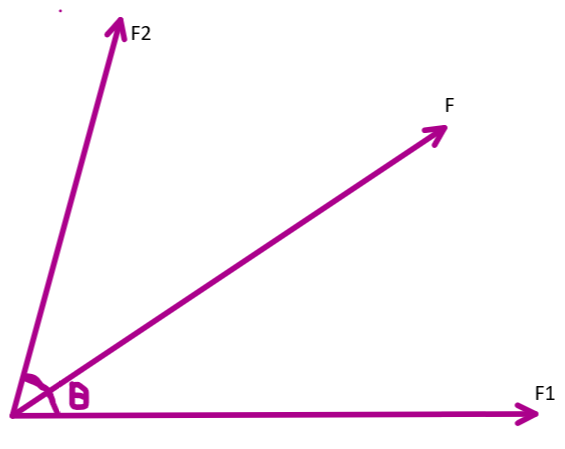
At what angle must two forces \[(x+y)\text{ and (}x-y)\] act so that the resultant force will be \[\sqrt{{{x}^{2}}+{{y}^{2}}}\]?
Answer
570.3k+ views
Hint: It is given that the two forces act in an angle such that its magnitude is a known fixed value. To solve this, we need to use the equations that give the magnitude of two or more vector quantities and substitute all the forces and find the angle involved.
Complete step-by-step solution

We know that any vector quantities can be added or subtracted by using the angle involved between them and the magnitudes using triangle law of parallelogram law of vector addition. We can just find the magnitude and direction also by means of equations derived from these laws.
Let us consider \[{{Z}_{1\text{ }}}\text{and }{{Z}_{2}}\]as two vectors. They are acting at an angle \[\theta \] with each other. For such a case, the resultant of the two vectors ‘Z’ is given by -
i.e., \[Z=\sqrt{{{Z}_{1}}^{2}+{{Z}_{2}}^{2}+2{{Z}_{1}}{{Z}_{2}}\cos \theta }\]
Thus, we can find the resultant of any two vectors with a given angle. Now, what happens when the resultant vector is given and we need to find the angle at which these vectors act so that they have a required resultant vector. It is very easy to find the angle from the cosine function, which follows.
Let us consider two forces as given in the question as –
\[{{F}_{1}}=(x+y)\text{ and }{{\text{F}}_{2}}\text{=(}x-y)\]
The magnitude of the resultant of two forces can be given by –
\[F=\sqrt{{{F}_{1}}^{2}+{{F}_{2}}^{2}+2{{F}_{1}}{{F}_{2}}\cos \theta }\]
Here, we are given that
\[{{F}_{1}}=(x+y)\text{ and }{{\text{F}}_{2}}\text{=(}x-y)\],
\[\begin{align}
& \Rightarrow \text{ }F=\sqrt{{{(x+y)}^{2}}+{{(x-y)}^{2}}+2(x+y)(x-y)\cos \theta } \\
& \Rightarrow \text{ }F=\sqrt{2{{x}^{2}}+2{{y}^{2}}+(2{{x}^{2}}-2xy+2xy-2{{y}^{2}})\cos \theta } \\
\end{align}\]
But it is already given that,
\[\begin{align}
& F=\sqrt{{{x}^{2}}+{{y}^{2}}} \\
& \Rightarrow \text{ }\sqrt{{{x}^{2}}+{{y}^{2}}}=\sqrt{2{{x}^{2}}+2{{y}^{2}}+(2{{x}^{2}}-2xy+2xy-2{{y}^{2}})\cos \theta } \\
& \Rightarrow \text{ }{{\text{x}}^{2}}+{{y}^{2}}=2{{x}^{2}}+2{{y}^{2}}+(2{{x}^{2}}-2{{y}^{2}})\cos \theta \\
& \Rightarrow \text{ }{{x}^{2}}+{{y}^{2}}+(2{{x}^{2}}-2{{y}^{2}})\cos \theta =0 \\
& \Rightarrow \text{ }\cos \theta =\dfrac{-({{x}^{2}}+{{y}^{2}})}{2({{x}^{2}}-{{y}^{2}})} \\
& \Rightarrow \text{ }\theta ={{\cos }^{-1}}(\dfrac{-({{x}^{2}}+{{y}^{2}})}{2({{x}^{2}}-{{y}^{2}})}) \\
\end{align}\]
This is the required angle at which the force should act.
Additional Information: The magnitude of a resultant vector is dependent on the angle between two or more vectors.
Note: This is the simplest method of calculating the required angle for the resultant force. We can use diagram interpretation and vector summing using the unit vectors to find the answer which is tedious and may produce wrong solutions if not considered seriously.
Complete step-by-step solution

We know that any vector quantities can be added or subtracted by using the angle involved between them and the magnitudes using triangle law of parallelogram law of vector addition. We can just find the magnitude and direction also by means of equations derived from these laws.
Let us consider \[{{Z}_{1\text{ }}}\text{and }{{Z}_{2}}\]as two vectors. They are acting at an angle \[\theta \] with each other. For such a case, the resultant of the two vectors ‘Z’ is given by -
i.e., \[Z=\sqrt{{{Z}_{1}}^{2}+{{Z}_{2}}^{2}+2{{Z}_{1}}{{Z}_{2}}\cos \theta }\]
Thus, we can find the resultant of any two vectors with a given angle. Now, what happens when the resultant vector is given and we need to find the angle at which these vectors act so that they have a required resultant vector. It is very easy to find the angle from the cosine function, which follows.
Let us consider two forces as given in the question as –
\[{{F}_{1}}=(x+y)\text{ and }{{\text{F}}_{2}}\text{=(}x-y)\]
The magnitude of the resultant of two forces can be given by –
\[F=\sqrt{{{F}_{1}}^{2}+{{F}_{2}}^{2}+2{{F}_{1}}{{F}_{2}}\cos \theta }\]
Here, we are given that
\[{{F}_{1}}=(x+y)\text{ and }{{\text{F}}_{2}}\text{=(}x-y)\],
\[\begin{align}
& \Rightarrow \text{ }F=\sqrt{{{(x+y)}^{2}}+{{(x-y)}^{2}}+2(x+y)(x-y)\cos \theta } \\
& \Rightarrow \text{ }F=\sqrt{2{{x}^{2}}+2{{y}^{2}}+(2{{x}^{2}}-2xy+2xy-2{{y}^{2}})\cos \theta } \\
\end{align}\]
But it is already given that,
\[\begin{align}
& F=\sqrt{{{x}^{2}}+{{y}^{2}}} \\
& \Rightarrow \text{ }\sqrt{{{x}^{2}}+{{y}^{2}}}=\sqrt{2{{x}^{2}}+2{{y}^{2}}+(2{{x}^{2}}-2xy+2xy-2{{y}^{2}})\cos \theta } \\
& \Rightarrow \text{ }{{\text{x}}^{2}}+{{y}^{2}}=2{{x}^{2}}+2{{y}^{2}}+(2{{x}^{2}}-2{{y}^{2}})\cos \theta \\
& \Rightarrow \text{ }{{x}^{2}}+{{y}^{2}}+(2{{x}^{2}}-2{{y}^{2}})\cos \theta =0 \\
& \Rightarrow \text{ }\cos \theta =\dfrac{-({{x}^{2}}+{{y}^{2}})}{2({{x}^{2}}-{{y}^{2}})} \\
& \Rightarrow \text{ }\theta ={{\cos }^{-1}}(\dfrac{-({{x}^{2}}+{{y}^{2}})}{2({{x}^{2}}-{{y}^{2}})}) \\
\end{align}\]
This is the required angle at which the force should act.
Additional Information: The magnitude of a resultant vector is dependent on the angle between two or more vectors.
Note: This is the simplest method of calculating the required angle for the resultant force. We can use diagram interpretation and vector summing using the unit vectors to find the answer which is tedious and may produce wrong solutions if not considered seriously.
Recently Updated Pages
Master Class 11 Economics: Engaging Questions & Answers for Success

Master Class 11 English: Engaging Questions & Answers for Success

Master Class 11 Social Science: Engaging Questions & Answers for Success

Master Class 11 Biology: Engaging Questions & Answers for Success

Class 11 Question and Answer - Your Ultimate Solutions Guide

Master Class 11 Business Studies: Engaging Questions & Answers for Success

Trending doubts
10 examples of friction in our daily life

One Metric ton is equal to kg A 10000 B 1000 C 100 class 11 physics CBSE

Difference Between Prokaryotic Cells and Eukaryotic Cells

1 Quintal is equal to a 110 kg b 10 kg c 100kg d 1000 class 11 physics CBSE

Explain zero factorial class 11 maths CBSE

What is a periderm How does periderm formation take class 11 biology CBSE




